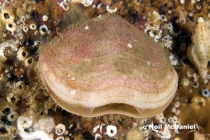WoRMS taxon details
Terebratalia transversa (Sowerby, 1846)
235615 (urn:lsid:marinespecies.org:taxname:235615)
accepted
Species
Magasella radiata Dall, 1877 · unaccepted > junior subjective synonym
Terebratalia caurina (Gould, 1850) · unaccepted > junior subjective synonym
Terebratella transversa (Sowerby, 1846) · unaccepted > superseded combination
Terebratula caurina Gould, 1850 · unaccepted > superseded combination
Terebratula transversa Sowerby, 1846 · unaccepted > superseded combination
marine, brackish, fresh, terrestrial
recent + fossil
(of Terebratula transversa Sowerby, 1846) Sowerby, G. B. (1846). Descriptions of thirteen new species of brachiopods. <em>Proceedings of the Zoological Society of London.</em> 14: 91-97. [details] 
Stratigraphy Terebratalia transversa is a living species, but fossil material attributable to this species also dates back to the...
Stratigraphy Terebratalia transversa is a living species, but fossil material attributable to this species also dates back to the Oligocene (northwestern American deposits, adjacent to the current distribution). [details]
Verhoeff, T. (2024). World Brachiopoda Database. Terebratalia transversa (Sowerby, 1846). Accessed through: World Register of Marine Species at: https://www.marinespecies.org/aphia.php?p=taxdetails&id=235615 on 2024-04-16
![]() The webpage text is licensed under a Creative Commons Attribution 4.0 License
The webpage text is licensed under a Creative Commons Attribution 4.0 License
original description
(of Terebratula transversa Sowerby, 1846) Sowerby, G. B. (1846). Descriptions of thirteen new species of brachiopods. <em>Proceedings of the Zoological Society of London.</em> 14: 91-97. [details] 
original description (of Terebratula caurina Gould, 1850) Gould, A. A. (1850). [descriptions of new species of shells from the United States Exploring Expedition]. <em>Proceedings of the Boston Society of Natural History.</em> 3: 151-156, 169–172, 214-218, 252–256, 275–278, 292–296, 309–312, 343–348., available online at http://biodiversitylibrary.org/page/8870453 [details]
original description (of Magasella radiata Dall, 1877) Dall, W.H. (1877). Report on the Brachiopoda of Alaska and the adjacent shores of Northwest America. <em>Proceedings of the Academy of Natural Sciences of Philadelphia.</em> 29: 155-170. [details]
basis of record Dall, W. H. (1920). Annotated list of the recent Brachiopoda in the collection of the United States National Museum, with descriptions of thirty-three new forms. <em>Proceedings of the United States National Museum.</em> 57(2314):261–377., available online at https://repository.si.edu/bitstream/handle/10088/15121/USNMP-57_2314_1920.pdf?sequence=1&isAllowed=y
note: Provides a brief description, synonymy list, and list of occurrences (p. 339). [details]
additional source Logan, A. (2007). Geographic distribution of extant articulated brachiopods. <em>In: Treatise on Invertebrate Paleontology, Part H, Brachiopoda (revised), vol.6, 3082–3115. Geological Society of America, Boulder, Colorado, and University of Kansas Press, Lawrence, Kansas.</em> [details]
additional source Stiasny, G. (1933). VI. Verzeichnis der Brachiopoden-Sammlung des naturhistorischen Reichsmuseums in Leiden. <em>Uitgegeven door het Rijksmuseum van natuurlijke historie te. Deel XV. LEIDEN. Aflevering 3-4.</em> 129-148. [details]
new combination reference Beecher, C. E. (1893). Revision of the families of loopbearing Brachiopoda. The development of Terebratalia obsoleta Dall. <em>Connecticut Academy of Arts and Sciences, Transactions.</em> 9(2): 376–399, 3 pl., available online at https://www.biodiversitylibrary.org/page/27724820
note: Beecher (1893) allocated the species to genus Terebratalia. [details]
original description (of Terebratula caurina Gould, 1850) Gould, A. A. (1850). [descriptions of new species of shells from the United States Exploring Expedition]. <em>Proceedings of the Boston Society of Natural History.</em> 3: 151-156, 169–172, 214-218, 252–256, 275–278, 292–296, 309–312, 343–348., available online at http://biodiversitylibrary.org/page/8870453 [details]
original description (of Magasella radiata Dall, 1877) Dall, W.H. (1877). Report on the Brachiopoda of Alaska and the adjacent shores of Northwest America. <em>Proceedings of the Academy of Natural Sciences of Philadelphia.</em> 29: 155-170. [details]
basis of record Dall, W. H. (1920). Annotated list of the recent Brachiopoda in the collection of the United States National Museum, with descriptions of thirty-three new forms. <em>Proceedings of the United States National Museum.</em> 57(2314):261–377., available online at https://repository.si.edu/bitstream/handle/10088/15121/USNMP-57_2314_1920.pdf?sequence=1&isAllowed=y
note: Provides a brief description, synonymy list, and list of occurrences (p. 339). [details]
additional source Logan, A. (2007). Geographic distribution of extant articulated brachiopods. <em>In: Treatise on Invertebrate Paleontology, Part H, Brachiopoda (revised), vol.6, 3082–3115. Geological Society of America, Boulder, Colorado, and University of Kansas Press, Lawrence, Kansas.</em> [details]
additional source Stiasny, G. (1933). VI. Verzeichnis der Brachiopoden-Sammlung des naturhistorischen Reichsmuseums in Leiden. <em>Uitgegeven door het Rijksmuseum van natuurlijke historie te. Deel XV. LEIDEN. Aflevering 3-4.</em> 129-148. [details]
new combination reference Beecher, C. E. (1893). Revision of the families of loopbearing Brachiopoda. The development of Terebratalia obsoleta Dall. <em>Connecticut Academy of Arts and Sciences, Transactions.</em> 9(2): 376–399, 3 pl., available online at https://www.biodiversitylibrary.org/page/27724820
note: Beecher (1893) allocated the species to genus Terebratalia. [details]
 Present
Present  Present in aphia/obis/gbif/idigbio
Present in aphia/obis/gbif/idigbio  Inaccurate
Inaccurate  Introduced: alien
Introduced: alien  Containing type locality
Containing type locality
From editor or global species database
Stratigraphy Terebratalia transversa is a living species, but fossil material attributable to this species also dates back to the Oligocene (northwestern American deposits, adjacent to the current distribution). [details]
